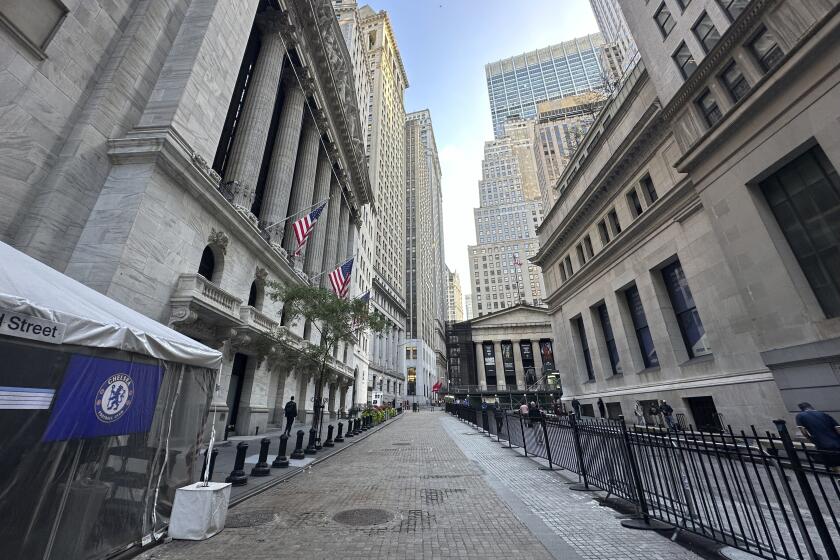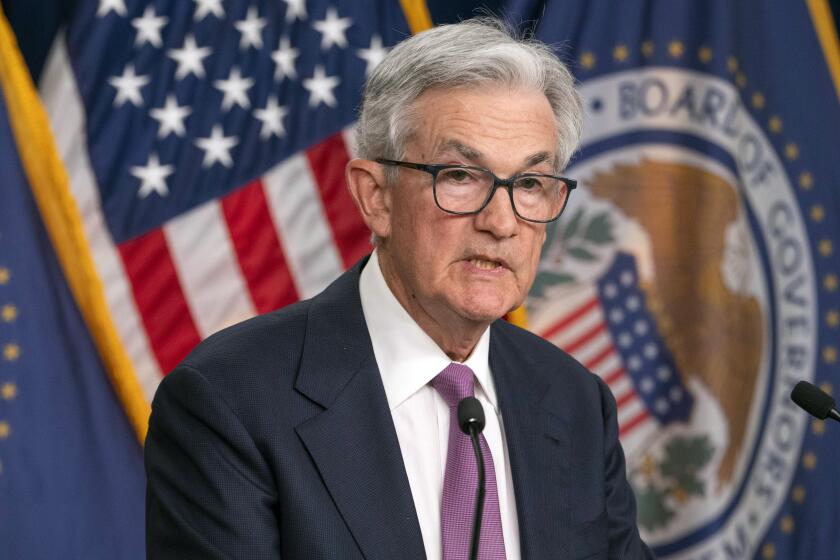Tech Sell-Off Spreads in Brutal Quarter
The bear ruled Wall Street in the first quarter, and a new generation of investors learned just how merciless that animal can be.
Stocks closed out the quarter Friday with modest gains, but they could hardly make a dent in the losses suffered in the three months.
What last year had primarily been a technology stock sell-off spread in the first quarter as investors feared that the slowing economy would slam corporate profits across the board.
And they were right: Hundreds of companies from virtually every industry sector have warned that near-term earnings will be disappointing, if not downright dismal.
The dimming picture for earnings sent the blue-chip Standard & Poor’s 500 index into its worst decline since 1987. Thought it gained 1.1% on Friday, the S&P; lost 12.1% in the quarter and is down 24% from its record high reached in March 2000.
The Dow Jones industrial average rose 79.72 points, or 0.8%, Friday to close at 9,878.78 but still posted its biggest percentage decline--an 8.4% loss--of any first quarter since 1978.
But blue-chip stocks’ losses were paper cuts compared with what happened to technology shares. The tech-dominated Nasdaq composite index, which had plunged 39.3% in 2000, sank 25.5% in the first quarter, bringing its loss from its March 2000 peak to nearly 64%.
That eclipsed even the price collapse of 1973-74, the worst since the Depression.
On Friday, Nasdaq rose 19.69 points, or 1.1%, to 1,840.26, inching up from Thursday’s 28-month low.
Many investors have given up hope for any tech stock rebound in the near term, given the barrage of bad sales and earnings news still pouring from Silicon Valley. But some market pros say the sector could be ripe for at least a short-term snap-back in coming weeks, now that quarter-end “window dressing” is over.
Tech stocks were hammered anew in recent weeks as some portfolio managers sought to further reduce their holdings rather than have clients question why those stock losers were on first-quarter statements.
As the second quarter begins, some managers may be tempted to buy back some of those tech names, betting that the worst is indeed over, analysts say.
But the broad market’s trend hasn’t been giving much encouragement to the bulls. Last year, sectors such as small and mid-size “value” stocks held up well even as tech melted down. In the first quarter, however, it was much harder to pick a winner on Wall Street:
* Within the S&P; mid-cap 400 stock index, 70% of the index’s 57 industry groups lost ground in the quarter. Within the S&P; small-cap 600, 58% of 95 industry groups were down.
* Of the 30 stocks in the Dow industrial average, just seven advanced in the quarter.
* Even classic “defensive” sectors that usually do well in a weak economy--such as drug stocks and electric utility shares--were hammered, though portfolio window-dressing helped boost them this week.
* Preliminary data from mutual fund tracker Morningstar Inc. show that only one of 28 stock fund sectors ended the quarter with a gain. That was the small-value-stock sector, which inched up 0.7%.
Value-oriented stock funds overall held up far better than growth-oriented funds in the first quarter, though most still fell. Large-value-stock funds lost 5.9% in the period, but that was modest compared with the 20.3% plunge in large-growth-stock funds, according to Morningstar.
Mid-cap-value funds eased 2.7% in the quarter, versus a 22.8% drop for mid-cap-growth funds.
The stock groups that did attract buyers were an eclectic mix, including engineering companies, independent power producers, home builders and makers of gifts and jewelry.
Overall, though, investors ignored one of Wall Street’s long-held rules: that it’s bullish for stocks when the Federal Reserve is cutting interest rates.
The Fed’s first cut, on Jan. 3, did produce a rally, sending the broad market higher in January. But the second and third cuts, on Jan. 31 and March 20, were met with scowls and howls from investors who believe the Fed is going too slow to save the economy from recession.
Many investors had a better idea than to trust the Fed and buy stocks: They bought bonds instead, as the concept of earning guaranteed interest gained much more appeal in an environment of sinking share prices.
The Fed’s rate cuts also drove bonds, of course, because investors figured it was now or never to lock in attractive yields.
But in recent weeks, some buyers of junk corporate bond offerings have been having second thoughts. Yields on those issues have begun to rise again, which could reflect deepening concern about the economy.
Investors hoping to find refuge in foreign stock markets in the first quarter were mostly foiled. Japan’s Nikkei stock average lost 5.7% for the quarter in yen terms and 15% in dollar terms, as the yen slumped further against the buck.
Most other foreign markets also fell with Wall Street. The German market dived 9.4%, and the British market lost 9.5%. Canada’s market lost 14.8%, and Hong Kong slumped 15.5%.
The Mexican market, however, managed a 1.3% gain.
(BEGIN TEXT OF INFOBOX / INFOGRAPHIC)
1st-Quarter Market Roundup
Bears -- and Bonds -- Rule
Wall Street’s bear market became official in the first quarter in more than just Nasdaq, as selling spread to the majority of stock sectors. Fears over the weak economy failed to be offset by the Federal Reserve’s three interest rate cuts. But those cuts were welcomed by the bond market, where yields dived--in part because investors were as eager to own interest-bearing securities as they were to dump former tech-stock stars.
... As Most Market Sectors Lost Ground
Percentage of industry groups in first quarter rising or falling:
S&P; 500
Leaders: Engineering;
long-distance telecom; toys
S&P; mid-cap
Leaders: Power producers; grocery stores; home builders
S&P; small-cap
Leaders: Textile makers; dept. stores; gifts and jewelry
The Fed’s Cuts Helped Bonds . . .
Yields on a key index of 100 corporate junk bonds and on the two-year U.S. Treasury note, weekly closes:
Junk bonds
2-year T-note
. . . And Investors Ate Them Up
Dollar volume of investment-grade corporate bonds issued each quarter, in billions:
2001 QI:
$202 billion
Sources: Times research, Bloomberg News, Securities Data/Thomson Financial *
Market Roundup, C4
More to Read
Inside the business of entertainment
The Wide Shot brings you news, analysis and insights on everything from streaming wars to production — and what it all means for the future.
You may occasionally receive promotional content from the Los Angeles Times.






